This essay was originally written as a blueprint for my speech at Extro-3 as a continuation of my thoughts on technological augmentation of humans and general functional evolution. I am still polishing it, and would welcome any suggestions and criticisms.
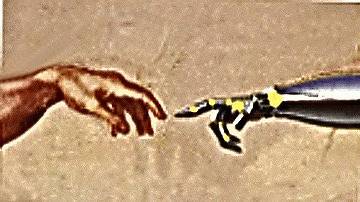
Introduction
People usually agree that we are living through a technological revolution, yet they seem confused about what this means. By definition, a revolution is a leap between two quasi-stationary stages. If we want to understand the meaning of a revolution, we should identify the current stage, the next stage, and the nature and purpose of the transition.There are many opinions about the meaning of technological progress. Typical discussions of technological changes consist of surface observations of current phenomena. Usual discourse about transitions to cyberspace and things electronic, digital, and democratic doesn't explore where these transitions originate, how they fit into the grand-scale evolutionary process, and what may happen next. This essay attempts to classify current technologies in the context of general historical progess of complex systems evolution, analyze history of relations of humans and technology, and envision some long-term future trends.
Evolution of functional structures
There are different ways to look at what currently exists, what constitutes an identity, and what is being augmented. We can examine the distributed environment of functional patterns temporarily incorporated in bodies, brains, machines, and social structures.In this essay I will utilize the common model of the world as based on physical elements of people, with their bodies, tools, and ideas. Today there is much stronger integration of features within a physical body, so physical entities are conscious, and understandably they want to talk to each other about their own development. In the not-so-distant future distributed entities may become more conscious, and then they will talk to each other in different terms.
We can view the world as an arena of systems evolution. To maintain competitive efficiency, systems have to develop certain features, such as complexity, integration, and [what I call] liquidity. They also should be able to utilize the legacy of system structures that were developed earlier and often for quite different purposes.
Complexity and integration are useful for optimizing current behavior; liquidity allows transformations and growth. All three are means, not ends, however. Nobody is interested in making things more complex or integrated just for the fun of it. Within any complexity limit, one can implement only a limited number of functions, so competition provides the impetus for systems to attempt more and more complex patterns.
By liquidity, I mean two things. One, is independence of structure from the physical substrate, facilitating more replication and other functions. Structures originally imbedded in the substrate developed more independence. Things like pressure, waves, and electric current, can already move across the substrate - so techniques of moving bits without moving atoms are actually billions of years old. Crystal structures can replicate more complex patterns within the same material; living organisms pass features and behavioral patterns to physically unconnected bodies; information technology allows structures to travel between different substrates and change representations (which is basically the same thing but one level of abstraction higher - it is passing semantics between different syntactic substrates).
Replication represents only obe simple aspect of functional evolution. It allows proliferation, but not qualitative growth. For growth, systems must possess internal structural liquidity. Functional structures should be able to modify themselves and combine with each other, to optimize behavior, to adapt to changing conditions, and to occupy new domains. This liquidity requires generalized layered architectures, modular adaptable designs, common communication interfaces, etc.
In a search for compromise between complexity, integration, and liquidity, the evolutionary process invented a system of organisms. Physical connections within an organism allow it to form a complex and integrated functional unit. At the same time, by making bodies temporary and assembling real living systems - ecologies and societies - out of dynamic configurations of communicating organisms, nature achieves the liquidity necessary for growth.
It is difficult to assemble a complex living system from identical functional bodies performing similar functions - there are too many tasks to perform to put each of them within one organism.
Therefore, functional bodies specialize. Biological organisms specialize, with different species performing different functions - that happens in ecologies and early human societies, with domestication of animals. In a human society, where a phenotypic variance is relatively small, generic bodies can learn and integrate different skills. This is still insufficient for unlimited growth, because of two reasons:
The physical abilities of an organism are limited, and it is very difficult to develop additional functions through a trial-and-error method.
The following picture illustrates the appearance of a complex functional
entity if it permanently incorporated all useful functions in one physical
body.
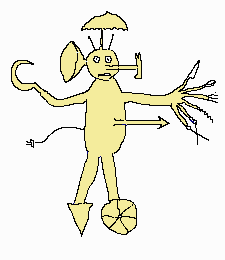
It is clumsy; the person would have to carry all specialized implements
everywhere, even when just one of them is needed. Evolving such a body
would also be difficult, as mutations in each function would have a smaller
and smaller influence on the survival of an organism, slowing the
evolutionary process. The solution here is a dynamic physical configuration.
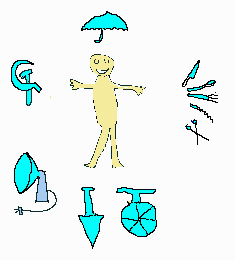
Here, the original organism forms a generic core that accepts attachments and extensions on a permanent (learning) or temporary basis. The attachments get tested and evolve independently, which dramatically speeds up the development. Also, this allows specialized personality configurations useful for social division of labor.
This "dividual" construct lies in the foundation of human nature, and even though accepting attachments takes a lot of learning and practicing, and will never be done with the "Plug and play" ease that we now implement in our computers. Still, it allows much faster evolution than that previously achieved in the pre-human world.
Individuals have their value and take pride in having strong bodily features; for the next stage, the more important thing is to own lots of resources and tools and be able to manipulate them, and take part in the division of labor - that's exactly the current human perception of self-worth.
The second limitation of a human organism lies in the limits of its functional abilities and architecture. So we need to extend our memory and intelligence as well, which is what we are trying to do now with the information technology.
Human role/interface with attachments becomes increasingly abstract. From finding and manipulating a tool we turn to communicating to it. Ideally, we may just express our needs, and the tools will understand which of them can do it, and how it should be done. In many cases, we no longer take any part in making/"compiling" objects which may sometimes create an illusion that this production process is gone.
"We're starting a new chapter in technological history. Chapter one - machines built out of something; chapter two, machines built out of nothing. Merely enacted, temporarily embodied by an irrelevant hunk of metal, plastic and silicon called a computer".
[ David Gelernter, "Mirror worlds", p. 11 ]
I think that there are two processes here. One is that machines are getting increasingly independent from the substrate, and second, that the human role is shifting from compiling an object to creating a blueprint. You can say that people also "just compile" objects out of ideas, but since the production process takes a lot of human effort, it doesn't look that simple. With computers, the compilation happens even more often, but it is easier, and humans do not take part in it, so it may look like it isn't there anymore.
Enhancements: Typology and recent developments
To discuss technological enhancements of humans, we need to define the difference between naturally occurring human features and manufactured technology. The common view states that natural things are warm, soft, and fuzzy; that artificial things are cold, square, and have sharp edges; and that a human is whatever resides within the skin boundary. I would define technology as anything intentionally designed, even if no external physical objects have been used. As for the human identity, we can draw borders in different physical and functional places. I personally identify more with my writings than with bacteria in my stomach. The extensions can also be inside and outside the body or programmed within natural bodily functions such as language, or other artificial skills. I would like to suggest a classification of such enhancements based on their positions relative to the body and the functions they perform.Extensions: types and functions
Types of extensions
Attachments and interfaces mediate our interaction with the environment and usually are positioned on the surface of the body. Although they could also be located inside it. For example, I would call a receptor of X-rays an attachment, whether it is placed on the skin, or inside the body. Physical objects would be called tools or attachments, while information utilities would be called interfaces, but they basically play the same role. We can call a shovel an interface.Implants are internal enhancements. Most current implants are replacements, such as an artificial bone. They fix an existing function, rather than add a new one. Implants can also modify the functions of the body - drugs are a good example here - or add new functions. Only a few examples of implants currently add new functions, but we can imagine the eventual development of internal memory backups, artificial chromosomes, or PGP encryption of DNA.
An interesting category of implants is functional implants - they may be placed outside the body, but augment its internal functions. For example, a thermometer: it allows us to see our own body temperature in the way we naturally can't. Also, if you look at my notes for this speech, they are outside of my body, but still are an internal part of the lecture function, so I would also call them a functional implant. Much of software can be also classified as functional implants, as it augments our internal functions, such as memory and information processing skills.
What I call pseudo implants are external tools that feel like natural functions. For example, you can program an external filter to give you a signal when it notices an interesting object. This object can be highlighted or otherwise distinguished for a moment, to give you enough time to focus on it, but not enough to realize what triggered your attention. In effect, you would instantly see your name in a text or find Waldo in a puzzle as easily as you usually notice a source of loud noise or a bright light. Such an enhancement would feel like an internal function of your brain, though actually it is an external image pre-processor.
Wrapper is a term from the theory of legacy systems. Though not a special functional category, it still deserves a separate mention. Wrapping is the comprehensive augmentation of a certain function, when all or most contact of the original system with the environment becomes mediated through a layer of technology. Clothes are physical wrappers; our digestive systems are effectively wrapped, as we rarely eat food that hasn't been cooked, or at least cut, peeled or washed. A car is a transport wrapper - while a walking stick is a transport aid.
Implants are the most difficult enhancements, as the human body does not have clean internal interfaces that would allow easy physical combinations with technology. The external interfaces are a lot more flexible. So during all of human history augmentation of the body has been proceeding as additions of physically external elements, and most likely, this process will continue for a while. A physically mixed system is usually called a cyborg. I suggest to call a biological system with external technological extensions a functional cyborg, or a "fyborg".
In the following illustration, you can see a cyborg, a fyborg, a robot, and a natural human. Actually, the human looks natural only from outside, as she holds all kinds of artificially created concepts loaded into her head. Humans without downloaded knowledge do not exist anymore.
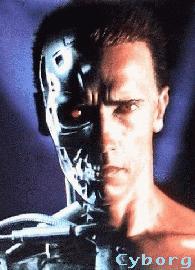

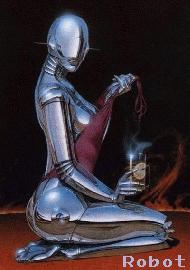

Another way of classifying the enhancements is by the functional role they play in the extended body.
System functions
Manipulators
Manipulators, or effectors, allow people to modify the environment.The first effectors were simple enhancements to human physical functions; people used sticks, shovels, or spears to augment their bodies. The general trend here runs toward growing sophistication and independence of tools which perform more functions and require less attention from a human. Weapons turned from sharpened sticks to things that act at a distance. With time, external tools started acting by themselves - that includes fire, mills, etc. Machines like mousetraps are already independent decision-making agents; they enact the logic delegated into them by their owner. Software agents are in principle the same thing, except they are more liquid. This allows them to perform remote functions, replicate in the environment, and perform many other function that physical implements cannot.
Sensors
Biological organisms possess two types of sensors: one to allow them to identify their internal states, the other - to analyze external conditions. Sensors of both types can be augmented and connected in various ways. An example of enhanced internal sensors is medical equipment that identifies the internal states that are not usually reported in the organism itself.Most interesting things have been happening with sensing of the environment. That includes collecting data from basically any source and location in time and space, and delivering it - if necessary, with change in representation - to human natural senses. Here we have radio, television, books, telephones, the Internet, etc. The latest trend here has been in increasing bandwidth and real-time interactivity. There are many interesting examples in this category. I am sure you know about work on remote input devices, such as cameras controlled over the Internet. Recently I saw a demonstration of a compass belt that buzzes on the side of your waist that is turned to the North, so you can always "feel" how you are oriented. There was also a suggestion to place taste buds on remote objects and transmit the signal to the nerves of your tongue so that you could taste things without actually touching them. I don't know whether you could poison yourself like this, but you definitely wouldn't gain weight.
It is possible to substitute internal sensors for external and vice versa. I already mentioned a thermometer that allows you to see your own body temperature. All medical diagnostic equipment and biofeedback devices belong to this category. It is also possible to do a reverse conversion, and channel information that would normally be perceived by external receptors, to internal sensors. For example, you could have an implant that generates a real pain in your neck each time the stock of your company goes down. - With both a physical implant and pain in one suggestion this of course sounds unpleasant. However, much of our pleasure and pain already come through technology. While animals feel direct pleasure from their productive behavior, human enjoyment from doing a good job usually comes mediated through money and various things it can buy. So poor performance of your investments does give you though indirect, but quite noticeable pain in the neck. And in the sense of external body, it is real pain and it goes through and registers in both your artificial and biological parts.
Resource storage - materials, energy, memory
Resource storage was the first "natural" function to migrate outside the body, starting with spare food items, followed by other kinds of useful materials and energy, then representations of these things (such as money and other contracts), and references to them - memory. At this point, people store more materials, energy and values outside their bodies than inside, and the external storage is often functionally superior to the internal.Storage systems have become increasingly distributed, shared and abstract, and also play an increasingly active role, deciding by themselves what to store, when to accumulate the resource and when to disburse it. Memory is probably the most interesting example here. Externally shared memory appeared long time ago, with marks on stones and trees. Now most objects around us are labeled, and a good half of our possessions is comprised of either carriers of memory, such as texts, pictures, movies, or music, or equipment for supporting and accessing it - from bookshelves to desk lamps to video cameras and computers.
A very interesting example of a memory enhancement is the remembrance agent created by Brad Rhodes and Thad Starner at MIT Media lab. It memorizes things that happen around you, and reminds you about them when you get into a similar situation, providing active external associative memory.
Transports - physical, signal, semantic
Originally, organisms relied on favorable external forces to bring them together with necessary resources. The next step was development of mobile organisms - animals - that move around looking for resources (they also provide transport services to other animals and plants that can reward them for the service). Human transportation systems use technological carriers to carry both people and resources where they are needed, a more efficient way of connecting organisms and resources. Ultimately, the transport function shifts from the organisms to technological systems.I would distinguish three layers of abstraction in value transports - physical, signal, and semantic.
Transport systems modify the effective geometry of the environment and allow creation of integrated distributed systems that may eventually replace a physical body as primary carriers of intelligence. Small improvements in the quality of vehicles and infrastructure shrink the effective metrics of the environment; new pathways and transportation methods introduce structural changes in the geometry and even the topology of social space.
Physical transports have been in use for thousands of years, and we have seen more and more improvements in types of vehicles and general infrastructure. New technologies, such as optimization of traffic, new materials, alternative sources of energy, navigational aids, and smart cars can bring dramatic improvements within the next few decades. My favorite urban transportation fantasy is to have all traffic lights removed, and have the cars move through intersections at 100 miles per hour, negotiating rights of passage with the cars on the crossing streets in real time, and paying each other for changing speed with digital cash. Another interesting recent development is autonomous vehicles and mobile robots. Building mobile robots still requires a lot of research in image recognition, but in one area - aerial robotics - this is not necessary (not much to bump into in the air yet). The specific difficulties of aerial robotics, the need in lightweight equipment for position identification and communication are now resolved with cellular modems and GPS. In the near future, maybe 5 to 10 years from now, aerial robots would be able to deliver small physical objects, observe remote locations (you can "walk" one in a Paris museum, or fly it over the jungle, looking for new species of birds). Small aerial robots may be also used for delivering drugs, spying after people, stealing things, or anonymous killing from the air. It seems that the features of small aerial robots - airborne, cheap and anonymous - allow them to perform acts from which the society has little protection. Introduction of aerial robots may deliver multiple benefits and at the same time create quite a turmoil that will only increase with the development of lots of swimming and running little robots.
When the environment becomes too complex, a new problem arises - knowing which things to transport and where to bring them. Often, people may be able to create necessary artifacts and transport them to places where they are needed, but they cannot do so when they do not know what to create and where they should deliver the products. As a result, the social space is divided into a set of functional fragments reflecting existing information pools, even though good transportation systems make the physical environment relatively liquid.
So the next stage is creation of an efficient system of signal transports that can carry information about available resources. This allows greater economic efficiency and faster growth, and also liberates exchange of ideas from territorial limitations.
Territorial power structures appeared under conditions when both physical and signal communications were slow and expensive, and so geographical boundaries determined the limits of cultural and economic entities. The conditions are dramatically different now, and all local structures are becoming less and less important. This means demise of territorial sovereignty and national states, and obsolescence of territorial wars in advanced economies.
We have already reached the point where transportation of physical objects, energy and information happens not as much between humans and their tools, but among the tools themselves, with humans, at best, overseeing the process. People still use both physical and information transports as well. There are millions of vehicles people acquire every year in USA alone to navigate the world - and the most favorite of them is... Netscape Navigator.
After a certain stage of development of signal communications, they start suffering from the same problem as physical transports: too much data and too many signals that render it difficult to figure out what should go where. Humans understand the semantics of signals, but each person has knowledge of only a few areas of expertise and data sources, and is increasingly overwhelmed even there.
Communication between these areas is imperfect because of semantic barriers - most people do not know each other, the organizational mechanisms of knowledge transfer between domains are relatively weak, and terminology and interests differ, which creates conditions of "reproductive isolation" in the memetic ecology.
Now the semantic space is fragmented, although the information environment is liquid, and we face a task similar to the one that led to the creation of the signal communication industry. We need to make the communication media aware of their content, and build a semantic transport system that would take an increasing role in determining what data should be stored and where, who should get signals and from which sources. This system should also pass information about different sources of data from one knowledge center to another.
Today, an increasing number of tools, from search engines to collaborative filtering schemes, store knowledge about available data and fulfill not only the requests for particular data items, but also requests for the type of desired knowledge, or even tell you what they decide may relate to your interests.
At the advanced stage of this process, humans may play the role of "semantic sensors", assessing the meaning and value of particular objects, and letting machines organize the global architecture of knowledge flows.
This seems to be the general tendency in the evolution of all enhancements. Originally, the tools, sensors, and transports were small and specialized, while humans determined the system architecture and provided general support and coordination. But now, humans specialize in creating particular artifacts and assessing their quality, and the machine economy provides the general structure. So each human is becoming a specialized tool in the automated distributed system.
It is likely that semantic transport will play as important a role in the advanced information economy as signal and physical transports play in the industrial age.
According to statistics, physical transportation alone accounts for 40% of all economic costs, depending on what you consider transportation. Is swallowing food transportation? Is data transfer between computer processor and memory transportation? If we divide things in this strict sense, into transportation, when the object structure persists, but location changes, and transformation, when the location persists but the structure changes, then transportation may account for 90+% of the costs. Sometimes it is not easy to make distinctions. For example, moving furniture from one wall to another may be considered transportation of furniture, but transformation of the office.
Communication
There is more to communication than just data transfer. Recently, many new tools have appeared for non-local real-time interaction between multiple parties, from teleconferencing to mediated physical connections. An interesting example here is the work of Stelarc, an Australian performance artist. He created a pair of robotic suits that can be remotely controlled. If I wear one of the suits and walk, the information about the position of my body can be transmitted to you over the Net, and the robotic suit you wear will make you repeat all my movements. Or the right part of my body can control the right part of your body, while your left part controls my left part. We can walk or dance as one body.Another interesting project is a device that allows people to automatically exchange personal data when they approach each other in the street.
Human abilities in communication are limited, and we are already close to our maximal capacity. It seems that in a decade or two we will be able to provide the maximal bandwidth that a human can perceive - that's a dedicated link with high-quality video and audio into each home. All further increase in data traffic will happen between the machines, so in another decade the traffic received by humans may be relatively so small that it may be delivered for free.
Selectors and filters choose and transform physical or data inputs. Information filters seem the most interesting. There are many methods for mediating our perception of the world, and the work here is just beginning, so I will try to classify the enhancements that I think should appear in the near future.
Perception filters and enhancements
All these tools need some device that can transform signals coming from the world before they reach your senses. Many techniques are already used in radio and TV programs, but I would like to see some real-time transformation of signals coming from the real world - what I call Enhanced Reality. Let us imagine that we are looking at the world through some smart glasses that do some pre-processing of incoming information. There are several kinds of tools I can envision:Volume and focus controls may allow to adjust the level of the signal or select and amplify small but important parts - for example, focus in on small or distant objects.
Calibration tools could expand the effective spectral range of your perception through alteration of the frequency of the signal to allow you to hear ultrasound or perceive X-rays and radio waves as visible light.
Conversions between different types of signals may allow you, for example, to "see" noise as fog while enjoying quiet. Most popular conversion already takes place via spoken and written language, by which we convert our experiences into a symbolic form. In real-time communication such symbolism may be mixed with the original message in a metaphoric form, for example your "smart glasses" could display the chemical composition of materials as color patterns. You can also convert the look of a good financial report into an intense physical pleasure.
Artificial annotations to perceived images could add text tags with names and descriptions to chosen objects, append warning labels with skull and crossbones to radioactive objects, or surround angry people with red auras. A person who has a reputation as a liar could appear to have a long nose (as you see here on the picture). Entering a high-crime area, people may see the sky darken and hear distant funeral music.
Reality filters may help you filter all signals coming from the world just like your favorite mail reader filters your messages, based on your stated preferences or advice from your peers. With such filters you may choose to see only the objects that are worthy of your attention, and completely remove useless and annoying sounds and images (such as advertisements) from your view.
Perception utilities may give you additional information
in a familiar way -- project clocks, thermometers, weather maps, and your
current EKG readings on the wall in front of you, or honk a virtual horn
every time a car approaches you from behind. They could also build on existing
techniques that present us with recordings of the past and forecasts of the
future to help people develop an immersive trans-temporal perception
of reality.
"World improvement"
Finally, completely artificial additions could project northern lights, meteorites, and supernovas upon your view of the sky, or populate it with flying toasters, or they could virtualize and superimpose on the image of the real world your favorite mythical characters and imaginary companions, and provide other educational and recreational functions.
In many cases, perception filters may provide us with more true-to-life information than our "natural" perception of reality. They could edit out mirages, show us our "real" images in a virtual mirror instead of the mirror images provided by the real mirror, or allow us to see through solid objects. They could also show us many interesting phenomena that human sensors cannot perceive directly and that we have thus far learned about from science only in the symbolic form.
Some of the interface enhancements can be made common, temporarily or permanently, for large communities of people. This would allow people to interact with each other using, and referring to, artificial extensions as if they were parts of the real world, and build a "mutual reality" of common perceptions and metaphors.
Eventually, with all these filters, our contacts with "raw reality" may become as rare as our consumption of raw meat.
An interesting question here is who should have a right to control how you perceive things. Can you morph your neighbors into pigs, or see them naked, or demand that your image must be erased from the view of strangers? Can you implement obscenity filters for your children, so they would never hear bad words and see anything disturbing? Or can you design an obscenity-enhancement filter for yourself? Will people fight for the "freedom of impression" that would allow them to perceive the world in a far more distorted way that any of today's drugs can possibly do? Or will the government decide what constitutes an "approved perception of reality"?
Currently, the general view on extended self is, that whatever is within your skin boundary, is your "sacred natural self", and nobody, including yourself, should modify, damage, or sell any part of it. Things that are outside the skin, are property, and occupy a very different status. With our increasing ability to manipulate the biological parts, and our growing dependence on technology, this attitude should eventually change. But knowing humans, we can hardly expect that this process will be efficient and peaceful.
Behavior of extensions: reactive and proactive
Another way to classify extensions is by the initiative they take in performing their actions. Extensions can perform designated tasks, which makes them into relatively passive tools - or they can understand the interests of a person, and pursue them, finding things to do and deciding how to do them. This is called proactive behavior, and such extensions may be called agents.Distant future
One of my favorite subjects in the evolution of the augmented self is the issue of identity. It is interesting that my native language, the Russian language doesn't have a word for "identity". Humans used to not change that much. In good old times, it used to be easy to understand what constituted an identity. It consisted of things that were physically attached to your bones, things that belonged to you, things you could feel, and things you could control, and all these things were more or less the same. Now these categories are increasingly different, and each of them is more and more dynamic. Things that you control may not be attached to you, you can control things that do not belong to you and aren't attached to anybody, parts of your physical body or intelligence may be owned by someone else, etc.Human rules of social interaction are based on the concept of the permanence of human identity. Without it, some social rules may become outmoded. For example, if a person breaks some laws, and then replicates into lots of clones, and modifies himself beyond recognition, who should be punished for the crime? If currently you may not be allowed into a court with cameras, weapons, or drugs, then what will they do if you could turn any part of your body into any of these things at any time? Would they restrict the quality of your visual memory and monitor the chemical composition of your blood stream?
So the personal identity turns into an increasingly fluid and reconfigurable thing. At some point, you may be able to change yourself rapidly and dramatically - and every once in a while experience kind of "death forward" - modification beyond recognition, in which you will lose your identity, in any reasonable sense of this word.
Most progress-oriented individuals would probably have very short identity life spans - and may not be interested in prolonging the lives of their physical substrates. A truly " morphologically free" person may change all his parts and their configuration, and preserve only the general goals. Though the goals will drift too. Even with our current inflexible designs, our fundamental goals and interests change several times during our lives. In advanced entities such processes would speed up. The outside observer, with some stretch of imagination, could still call such a sequence of goals, or "teleological thread", an identity, but the entities themselves may feel very different about it.
In the most distant future that I can envision, intelligent entities will be extremely fluid and highly independent from the physical substrate of the world. Charles Platt suggested to call them "infomorphs". although this term assumes at least some functional identity. In the real post-human future the identities may completely dissolve, and the world will represent a mix of a superliquid economy, cyberspace anarchy and distributed Artificial Intelligence. To current humans, it may look like crazy functional soup.